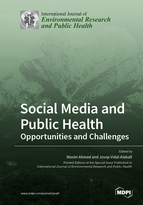Social Media and Public Health: Opportunities and Challenges
A special issue of International Journal of Environmental Research and Public Health (ISSN 1660-4601). This special issue belongs to the section "Health Communication and Informatics".
Deadline for manuscript submissions: closed (31 July 2020) | Viewed by 146878
Special Issue Editors
Interests: social media and public health
Special Issues, Collections and Topics in MDPI journals
Interests: primary health care; public health; social media; medical education; telemedicine; eHealth
Special Issues, Collections and Topics in MDPI journals
Special Issue Information
Dear Colleagues,
We are organising a Special Issue on the use of social media within public health in the journal International Journal of Environmental Research and Public Health. This journal is scientific and peer-reviewed, and publishes articles and communications in the interdisciplinary area of environmental health sciences and public health. For detailed information on the journal, we refer you to https://0-www-mdpi-com.brum.beds.ac.uk/journal/ijerph.
We are living in an information age, with more user-generated data being generated today than ever before with the widespread popularity of social media. Social media platforms provide the ability to extract intelligence for public health purposes. This can range from using social media to track the spread of diseases to the opinion mining of public views and opinions.
Social media has the potential to provide rapid insights into unfolding public health emergencies such as infectious disease outbreaks. They can also be drawn upon for rapid, survey-based insights into various health topics. Social media has also begun to be utilised by medical professionals for the purposes of sharing scholarly works, international collaboration, and engaging in policy debates.
A benefit of social media platforms for gaining insight into health is that they have the ability to capture unfiltered public opinion in large volumes, avoiding potential biases introduced by surveys or interviews. Social media platforms can also be utilised to pilot surveys, for instance, though the use of Twitter polls.
Social media data have also been drawn upon in medical emergencies and crisis situations as a public health surveillance tool. A number of software and online tools also exist that have been developed specifically to aide public health research utilising social media data. In recent years, ethical issues of retrieving and analysing data have also arisen.
Henceforth, we invite researchers who are working in the broad areas of social media and health to submit their research on these issues for publication in this Special Issue.
This Special Issue is open to any submission related to social media and public health, and the keywords provide some examples of various possibilities.
Dr. Wasim Ahmed
Dr. Josep Vidal-Alaball
Guest Editors
Manuscript Submission Information
Manuscripts should be submitted online at www.mdpi.com by registering and logging in to this website. Once you are registered, click here to go to the submission form. Manuscripts can be submitted until the deadline. All submissions that pass pre-check are peer-reviewed. Accepted papers will be published continuously in the journal (as soon as accepted) and will be listed together on the special issue website. Research articles, review articles as well as short communications are invited. For planned papers, a title and short abstract (about 100 words) can be sent to the Editorial Office for announcement on this website.
Submitted manuscripts should not have been published previously, nor be under consideration for publication elsewhere (except conference proceedings papers). All manuscripts are thoroughly refereed through a single-blind peer-review process. A guide for authors and other relevant information for submission of manuscripts is available on the Instructions for Authors page. International Journal of Environmental Research and Public Health is an international peer-reviewed open access monthly journal published by MDPI.
Please visit the Instructions for Authors page before submitting a manuscript. The Article Processing Charge (APC) for publication in this open access journal is 2500 CHF (Swiss Francs). Submitted papers should be well formatted and use good English. Authors may use MDPI's English editing service prior to publication or during author revisions.
Keywords
- Social media
- Public health
- Disease surveillance
- Health promotion
- E-health
- Telehealth
- Ethics
- Health informatics







